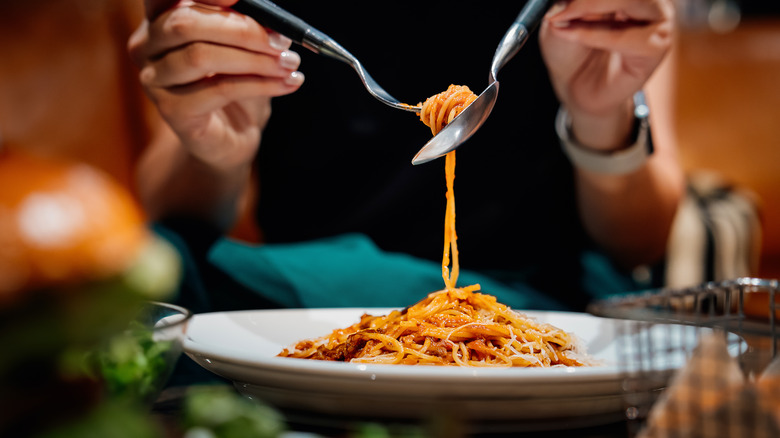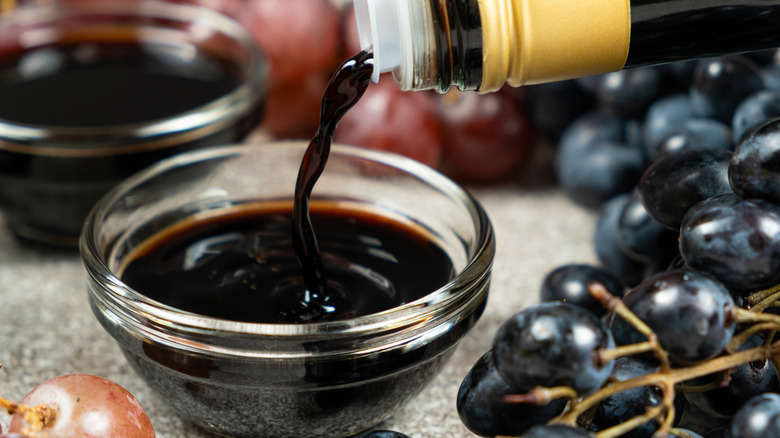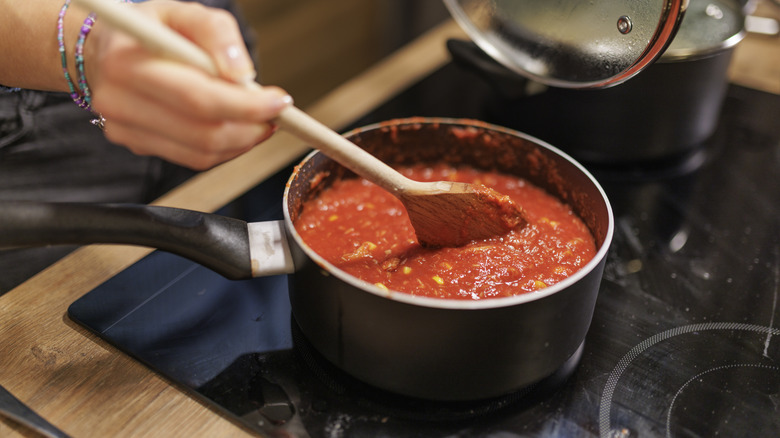Adding One Tangy Ingredient To Spaghetti Sauce Is A True Game Changer
If there's one thing I know, it's spaghetti. Figuring out early on just how versatile and satisfying a good plate of spaghetti can be sent me down a rabbit hole of sauces, seasonings, and styles. There's the bold and spicy kind, the sweet-and-kicky version, and the rich, savory type which leans on the sharp bite of parmesan for depth. Honestly, that's just scratching the surface of what spaghetti sauce can become.
But do you know what saved my behind more times than I can count when my spaghetti began teetering on "meh?" Balsamic vinegar. You never know just how far a splash of acidity can carry you. This salad dressing staple is known for its dark, sweet tang. When stirred into tomato sauce, it does a lot of heavy lifting to transform plain tasting sauce. It brightens the whole dish, deepens the overall flavor, and helps balance out the richness of meat and the heaviness of starchy pasta. Just a little bit added at the right time can take your sauce from flat to full-bodied without a total recipe overhaul.
Balsamic vinegar also happens to work well with ingredients already found in many classic spaghetti sauces such as garlic, onions, tomatoes, olive oil, and herbs. Even if you're not a confident cook, you don't have to measure it out with surgical precision. A teaspoon or two is usually enough to round out the flavor, but if you accidentally go a little heavy it won't completely ruin the sauce. Balsamic vinegar mellows as it heats, so consider adding it right before serving.
How balsamic vinegar brings out the best in tomato sauce
Tomato-based sauces naturally have a bit of acidity, but canned tomatoes and tomato paste can sometimes taste metallic or overly sharp. That's where real balsamic vinegar helps bring balance. It provides a rounded tartness along with a subtle sweetness, enhancing the complexity of the sauce without making it taste sugary. In other words, it makes the sauce taste like you spent all day making it, even if it only simmered for 30 minutes.
Balsamic vinegar also pairs with proteins like ground beef, Italian sausage, or lentils (if you're making a vegetarian version). Without it, your sauce might go too heavily in one direction. Either too acidic, too salty, or too flat. With a bit of balsamic, everything gets pulled together and tastes more intentional.
Timing matters here, too. As mentioned, the best moment to add balsamic vinegar is toward the end of cooking. That way, you keep its flavor intact without letting it completely evaporate. If you're nervous about going overboard, try adding just ½ teaspoon at a time, stir it in, and give the sauce a taste before deciding whether to add more. It's one of those easy upgrades that can elevate even the most basic pasta dinner.
It works for both store-bought and homemade sauces
One of the best parts about this tip is how flexible it is. You don't have to be making a sauce from scratch to take advantage of it. Balsamic vinegar works just as well when you're heating up a jar of marinara from the store. The only difference you may notice is that the store-bought sauce is already too sweet or too bitter right out of the jar. In which case, you may have to play around with the flavors a little more since you didn't control the spices from the beginning. Either way, you can toss it with pasta, layer it into lasagna, or spoon it over meatballs — it all works.
Whether you're pulling dinner together from scratch or giving a helping hand to a store-bought shortcut, balsamic vinegar is a small addition that can have an immediate effect. Just a quick pour, some stirring, and a swirl of pasta around your fork and you'll be eating spaghetti like Italians do.


